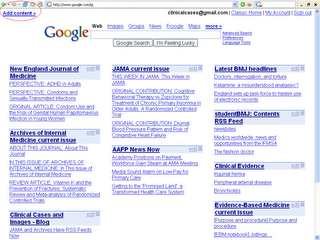 This is a collection of articles I have found interesting in the weekly editions of the "big five" medical journals: NEJM, JAMA, Annals, Lancet and BMJ (a few more journals are included occasionally). The review is a weekly feature of Clinical Cases and Images - Blog. Please see the end of the post for a suggested time-efficient way to stay up-to-date with the medical literature.
This is a collection of articles I have found interesting in the weekly editions of the "big five" medical journals: NEJM, JAMA, Annals, Lancet and BMJ (a few more journals are included occasionally). The review is a weekly feature of Clinical Cases and Images - Blog. Please see the end of the post for a suggested time-efficient way to stay up-to-date with the medical literature.------------------
Benazepril plus Amlodipine or Hydrochlorothiazide for Hypertension in High-Risk Patients
NEJM Volume 359:2417-2428 December 4, 2008 Number 23
The optimal combination drug therapy for hypertension is not established, although current U.S. guidelines recommend inclusion of a diuretic. In this study, the benazepril–amlodipine combination was superior to the benazepril–hydrochlorothiazide combination in reducing cardiovascular events in patients with hypertension who were at high risk for such events.
------------------
Irbesartan in Patients with Heart Failure and Preserved Ejection Fraction
NEJM Volume 359:2456-2467 December 4, 2008 Number 23
50% of patients with heart failure have a left ventricular ejection fraction of at least 45%, but no therapies have been shown to improve the outcome of these patients. Irbesartan did not either.
------------------
Clinical Equivalence of Generic and Brand-Name Drugs Used in Cardiovascular Disease
JAMA. 2008;300(21):2514-2526.
Use of generic drugs, which are bioequivalent to brand-name drugs, can help contain prescription drug spending. However, there is concern among patients and physicians that brand-name drugs may be clinically superior to generic drugs. A review of 47 articles did not support the notion that brand-name drugs used in cardiovascular disease are superior to generic drugs.
------------------
Alcohol Consumption and Risk of Incident Atrial Fibrillation in Women
JAMA. 2008;300(21):2489-2496.
Previous studies suggest that consuming moderate to high amounts of alcohol on a regular basis might increase the risk of developing atrial fibrillation in men but not in women. This study showed that among healthy middle-aged women, consumption of up to 2 alcoholic beverages per day was not associated with an increased risk of incident atrial fibrillation. More than 2 drinks per day was associated with a small but statistically significant increased risk of atrial fibrillation.
------------------
Hospital-wide Code Rates and Mortality Before and After Implementation of a Rapid Response Team
JAMA. 2008;300(21):2506-2513.
Rapid response teams have been shown in adult inpatients to decrease cardiopulmonary arrest (code) rates outside of the intensive care unit (ICU). In this large single-institution study, rapid response team implementation was not associated with reductions in hospital-wide code rates or mortality.
------------------
Circumcision — A Surgical Strategy for HIV Prevention in Africa
NEJM Volume 359:2412-2415 December 4, 2008 Number 23
------------------
A time efficient way to stay up-to-date with medical literature
"How do you eat in elephant? In small bites." The same rule probably applies to staying current with the ever expanding avalanche of medical literature. One can try the following approach:
1. Subscribe to the RSS feeds of the 5 major medical journals (NEJM, JAMA, BMJ, Lancet and Annals) plus 2-3 subpecialty journals in your field of interest.

Medical Journals tab: A screenshot of iGoogle with RSS feeds from the major medical journals.
2. Read the journal on the day it is published online, for example, NEJM on Wednesdays.
3. Use text-to-speech to listen to the articles you do not have time to read.
4. Listen to journal podcasts. Click here to subscribe the podcasts of the 4 major journals in iGoogle.
Related:
University of Oxford Journal Watch: Lighthearted Review of Medical Journals
5 Tips to Stay Up-to-Date with Medical Literature
Make Your Own "Medical Journal" with iGoogle Personalized Page
Share iGoogle Tabs with Medical Journals, Podcasts and Gadgets
Text-to-Speech Programs and Continuous Medical Education
Image source: OpenClipArt, public domain.
No comments:
Post a Comment